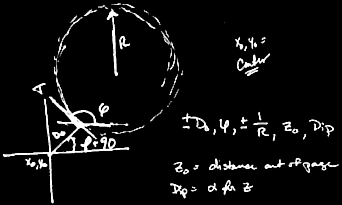The structural motif for Spirals&Tangents, the online "sketchbook" for The Spider Project, was inspired by the data encoding system used in the ALEPH detector of the CERN particle accelerator. The idea came to me as Dr. Hans Drevermann of CERN sketched out and described this method to me which uses the tangent and radius of a curve to efficiently identify a location within the detector. The method elegantly reduces the number of data points necessary for locating a point in a cylinder from six to five, a significant data reduction at 10,000 points / second throughput. The use of a curve and its tangent as an encoded notation of space has the refined quality of a poem. Likewise, the website is a series of tangents and curves, tangential connections to the central theme of the spiral cycle. The hypertext structure of the website is a natural format for joining discrete concepts, allowing for discontinuous jumps, multiple, minute associations, and non-linear traversal through various forms and disciplines of information.
 |
© Clea T. Waite, 2000
The Spider Project, inspired by the approach of the year 2000, is research project, a website, and an installation contemplating the basic forms of nature: creation and death, time, cycles, the elements, and the workings of the universe.
The Spider Project reviews scientific and technological developments, focusing on the 20th century as the Atomic Age. The piece also looks at environmental concerns - pollution, disease, and issues of ecological imperialism. The consequences as well as the discoveries of twentieth century civilization are part of the entire web.
Concentrating on spirals and circles as the central visual motif, the images derive from the micro and macroscopes which epitomize our time: subatomic particle data from CERN's accelerator, astral images from satellite telescopes, the human body as seen through various medical imaging technologies, sonar, radar, cosmic ray detectors, and camera lens pointed at nature from extraordinary perspectives. These are combined with the symbolic imagery representing life, death, and reincarnation from cultures around the world, the timeless images of the inner eye.
The change of the millennium has special meaning for the western world: it is a beginning and an end, but although the year 2000 is calculated according to a Christian calendar, Western philosophy lacks a premise for dealing with cycles and rebirth, a premise found in most other philosophical systems in the world. In The Spider Project, the visitor is guided with history, stories, poetry, and data . Myths from Native American cultures, India, Asia, Africa, Australia, Siberia, and Ancient Europe tell of the Spider Woman, the Mist Beings, Kali: the mythical tales of creation, destruction, and regeneration. Quotations from modern poets weave together with the ancient texts. Excerpts from newspaper articles give a more contemporary view.
The Spider Project creates a spiritual place without belonging to a religion - a cross-over point between profane and sacred thought, western rationalism and eastern philosophy, the 20th and the 21st centuries.
© Clea T. Waite, 1999